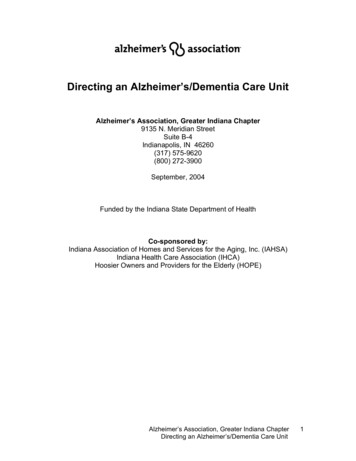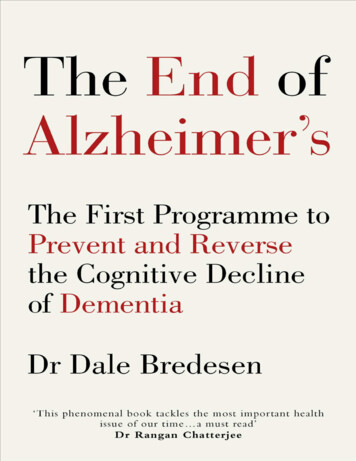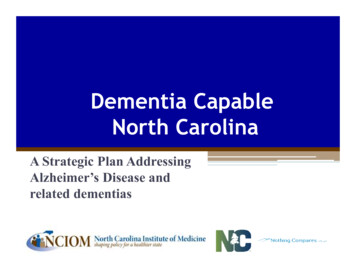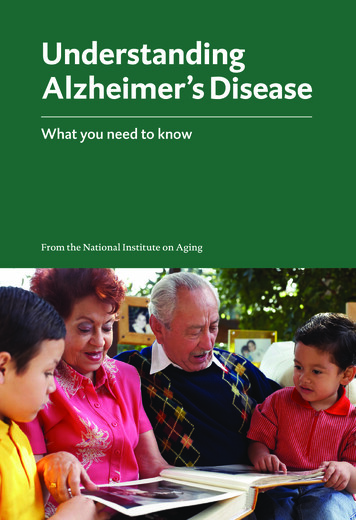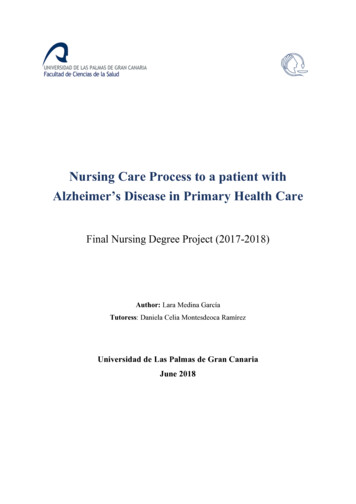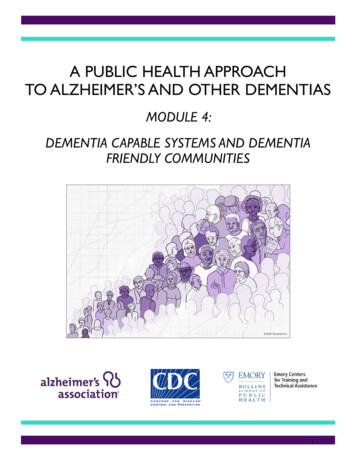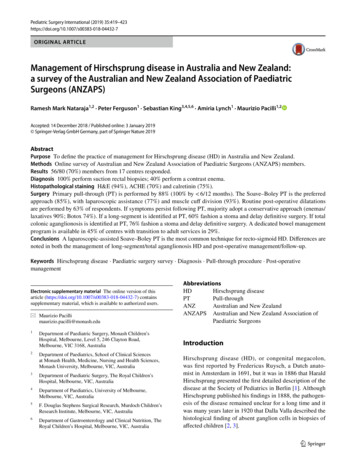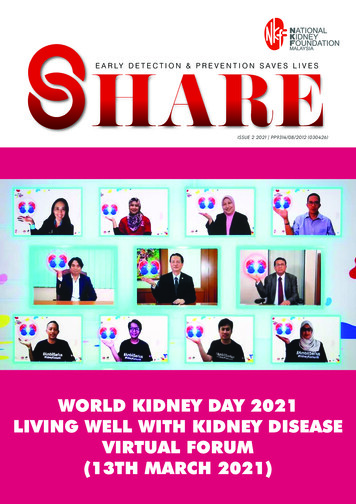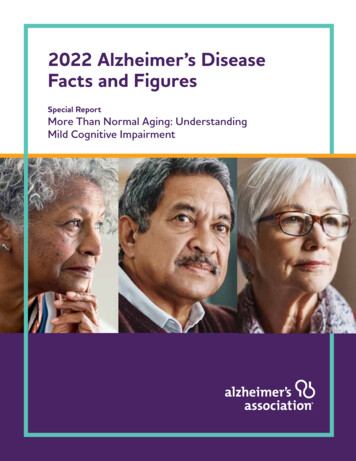
Transcription
2022 Alzheimer’s DiseaseFacts and FiguresSpecial ReportMore Than Normal Aging: UnderstandingMild Cognitive Impairment
About this report2022 Alzheimer’s Disease Facts and Figuresis a statistical resource for U.S. data relatedto Alzheimer’s disease, the most common causeof dementia. Background and context forinterpretation of the data are containedin the Overview. Additional sections addressprevalence, mortality and morbidity, caregiving,the dementia care workforce, and the use andcosts of health care, long-term care andhospice. A Special Report examines consumers’and primary care physicians’ perspectives onawareness, diagnosis and treatment of mildcognitive impairment (MCI), including MCI dueto Alzheimer’s disease.The statistics, facts, figures, interpretations and statements made in this report arebased on currently available data and information as cited in the report, all of which aresubject to revision as new data and information become available.Alzheimer’s Association. 2022 Alzheimer’s Disease Facts and Figures. Alzheimers Dement 2022;18.
Specific information in this year’sAlzheimer’s Disease Facts and Figures includes: Brain changes that occur with Alzheimer’s disease (page 8). Risk factors for Alzheimer’s dementia (page 13). Number of Americans living with Alzheimer’s dementia nationally (page 19)and for each state (page 22). Lifetime risk for developing Alzheimer’s dementia (page 24). Proportions of women and men with Alzheimer’s and other dementias (page 24). Number of deaths due to Alzheimer’s disease nationally (page 30) and for each state(page 33), and death rates by age (page 35). Number of family caregivers, hours of care provided, and economic value of unpaidcare nationally (page 38) and for each state (page 42). The impact of caregiving on caregivers (page 43). The roles of the paid workforce in diagnosing, treating and caring for people withAlzheimer’s or other dementias (page 53). National cost of care for individuals with Alzheimer’s or other dementias, includingcosts paid by Medicare and Medicaid and costs paid out of pocket (page 61). Medicare payments for people with dementia compared with people withoutdementia (page 65). The public's awareness of mild cognitive impairment (page 85). Primary care physicians’ perspectives on diagnosing mild cognitive impairment (MCI)and MCI due to Alzheimer’s disease (page 89).The Appendices detail sources and methods used to derive statistics in this report.When possible, specific information about Alzheimer’s disease is provided; in othercases, the reference may be a more general one of “Alzheimer’s or other dementias.”2022 Alzheimer’s Disease Facts and Figures1
ContentsOverviewPrevalenceMortality and MorbidityCaregivingAlzheimer’s Disease orDementia? 5Prevalence of Alzheimer’sand Other Dementiasin the United States 19Deaths from Alzheimer’sDisease 30Unpaid Caregivers Brain Changes ofAlzheimer’s Disease 8Prevalence Estimates Mixed Dementia 8Estimates of the Numberof People with Alzheimer’sDementia by State 24Alzheimer’s DiseaseContinuum 9When Dementia-LikeSymptoms Are NotDementia 10Treatments 12Active Managementof Dementia Due toAlzheimer’s Disease 13Risk Factors forAlzheimer’s 13Looking to the Future 1720Incidence of Alzheimer’sDementia 24Lifetime Risk ofAlzheimer’s Dementia 24Differences BetweenWomen and Men in thePrevalence and Riskof Alzheimer’s and OtherDementias 24Racial and EthnicDifferences in thePrevalence of Alzheimer’sand Other Dementias 25The Effect of the COVID-19Pandemic on Deaths fromAlzheimer's Disease 31Public Health Impact ofDeaths from Alzheimer’sDisease 34State-by-State Deathsfrom Alzheimer’s Alzheimer’s Death Rates 34Duration of Illness fromDiagnosis to Death 235Burden of Alzheimer’sDisease 35Looking to the Future Trends in the Prevalenceand Incidence ofAlzheimer’s DementiaOver Time 27Looking to the Future 3427Alzheimer’s Association. 2022 Alzheimer’s Disease Facts and Figures. Alzheimers Dement 2022;18.3638Who Are the Caregivers? 39Caregiving and Women 39Race, Ethnicity andDementia Caregiving 40Caregiving Tasks 40Duration of Caregiving 41Hours of Unpaid Careand Economic Value ofCaregiving 41Health and EconomicImpacts of Alzheimer’sCaregiving 43Interventions Designedto Assist Caregivers 47Trends in DementiaCaregiving 49COVID-19 andDementia Caregiving 50
WorkforceDiagnosis 53Treatment 55Care 55Workforce Needs forNew Therapies 56Barriers to DevelopingEnough Well-TrainedMembers of the Alzheimer’sand Dementia CareWorkforce 56Looking to the Future 58Use and Costs of HealthCare, Long-Term Careand HospiceTotal Cost of Health Careand Long-Term Care 61Special Report –More Than Normal Aging:Understanding MildCognitive ImpairmentConfronting MCI andWhy It Matters Use and Costs of LongTerm Care Services MCI Diagnosis andTreatment 8167Medicare Does NotCover Long-Term Carein a Nursing Home MCI Due to Alzheimer'sDisease: A DistinctCondition 8271MCI Due to Alzheimer'sDisease Represents aCritical Turning Pointin the Alzheimer'sDisease Continuum 76The COVID-19 Pandemicand Health CareUtilization and Costs 77Projections forthe Future 79968162Avoidable Use of HealthCare and Long-TermCare Services End Notes References 98Use and Costs of HealthCare Services Use and Costs of HealthCare and Long-TermCare Services by Race/Ethnicity 75Appendices83Understanding MCI and MCIDue to Alzheimer's DiseaseToday: U.S Adult and PrimaryCare Physician Surveys 84Key Findings 84Survey Design andResearch Methods 85Survey Results 85A Path Forward: IncreasingAwareness and Diagnosisof MCI and MCI Due toAlzheimer's Disease 90Conclusion 95Contents3
OVERVIEWAlzheimer's diseaseis the most commoncause of dementia.
Alzheimer’s disease is a type of brain disease,just as coronary artery disease is a type ofheart disease. It is caused by damage to nervecells (neurons) in the brain.The neurons damaged first are those inparts of the brain responsible for memory,language and thinking. As a result, the firstsymptoms of Alzheimer’s disease tend tobe memory, language and thinking problems.Although these symptoms are new to theindividual affected, the brain changes thatcause them are thought to begin 20 yearsor more before symptoms start.1-8Individuals with mild symptoms often may continue towork, drive and participate in their favorite activities,with occasional help from family members and friends.However, Alzheimer’s disease is a progressive disease,meaning it gets worse with time. How quickly itprogresses and what abilities are affected vary fromperson to person. Medications can temporarily helpneurons in the brain to communicate with each otherand in that way help symptoms for varying lengths oftime, but do not cure Alzheimer's.As time passes, more neurons are damaged and moreareas of the brain are affected. Increased help fromfamily members, friends and professional caregivers isneeded to carry out activities of daily living, A1 such asdressing and bathing, and to keep the individual safe.People may develop changes in mood, behavior orpersonality as a result of the thinking and memorychallenges they are experiencing. One area of specialconcern is preventing falls, which can cause head injury,fractures and hospitalization. Preventing wandering isanother area of special concern. Wandering refers toindividuals walking away from a particular location andbeing unable to retrace their steps. Individuals becomelost, putting them at risk of significant injury and death.9become bed-bound and require around-the-clock care.Ultimately, Alzheimer’s disease is fatal. Studies indicatethat people age 65 and older survive an average of fourto eight years after a diagnosis of Alzheimer’s dementia,yet some live as long as 20 years.10-18Alzheimer’s Disease or Dementia?Many people wonder what the difference isbetween Alzheimer’s disease and dementia.Dementia is an overall term for a particulargroup of symptoms. The characteristicsymptoms of dementia are difficulties withmemory, language, problem-solving andother thinking skills. Dementia has severalcauses (see Table 1, page 6). These causesreflect specific changes in the brain.Alzheimer’s disease is one cause of dementia.The brain changes of Alzheimer’s diseaseinclude the accumulation of the abnormalproteins beta-amyloid and phosphorylatedtau, as well as the degeneration of nervecells. The brain changes of Alzheimer’sdisease are the most common contributorto dementia.In this report, Alzheimer’s dementiarefers to dementia that is caused by,or believed to be caused by, the brainchanges of Alzheimer’s disease. It is usedinterchangeably with dementia due toAlzheimer’s disease.Eventually, the neuronal damage of Alzheimer’s diseaseextends to parts of the brain that enable basic bodilyfunctions such as walking and swallowing. IndividualsOverview5
1tableCommon Causes of Dementia and Associated iseaseThe hallmark pathologies of Alzheimer’s disease are the accumulation of the protein beta-amyloid (plaques)outside neurons and twisted strands of the protein tau (tangles) inside neurons in the brain. These changes areaccompanied by the death of neurons and damage to brain tissue. Alzheimer's is a slowly progressive braindisease that begins many years before symptoms emerge.Alzheimer's disease is the most common cause of dementia, accounting for an estimated 60% to 80% of cases.Recent large autopsy studies show that more than half of individuals with Alzheimer's dementia have Alzheimer'sdisease brain changes (pathology) as well as the brain changes of one or more other causes of dementia, suchas cerebrovascular disease or Lewy body disease. 21-22 This is called mixed pathologies, and if recognized duringlife is called mixed dementia.SymptomsDifficulty remembering recent conversations, names or events is often an early symptom; apathy and depressionare also often early symptoms. Later symptoms include impaired communication, disorientation, confusion, poorjudgment, behavioral changes and, ultimately, difficulty speaking, swallowing and walking.CerebrovasculardiseaseCerebrovascular disease refers to the process by which blood vessels in the brain are damaged and/orbrain tissue is injured from not receiving enough blood, oxygen or nutrients. People with dementia whosebrains show evidence of cerebrovascular disease are said to have vascular dementia.Vascular dementia occurs most commonly from blood vessel blockage, such as that which occurs with stroke,or damage leading to areas of dead tissue or bleeding in the brain. The location, number and size of the braininjuries determine whether dementia will result and how the individual’s thinking and physical functioning willbe affected. Some cerebrovascular disease is commonly present in people with Alzheimer’s, and may worsensymptoms. About 5% to 10% of individuals with dementia show evidence of vascular dementia alone. 21-22However, it is more common as a mixed pathology, with most people living with dementia showing the brainchanges of cerebrovascular disease and Alzheimer's disease. 21-22SymptomsSlowed thoughts or impaired ability to make decisions, plan or organize may be the initial symptoms, butmemory may also be affected, especially when the brain changes of other causes of dementia are present.In addition to changes in cognitive function, people with vascular dementia commonly become less emotionaland have difficulty with motor function, especially slow gait and poor balance.Lewy bodydiseaseLewy bodies are abnormal aggregations (or clumps) of the protein alpha-synuclein in neurons. When theydevelop in a part of the brain called the cortex, dementia can result. This is called dementia with Lewy bodiesor DLB.About 5% of older individuals with dementia show evidence of DLB alone, but most people with DLB also haveAlzheimer's disease pathology.SymptomsPeople with DLB have some of the symptoms common in Alzheimer’s, but are more likely to have initial or earlysymptoms of sleep disturbances, well-formed visual hallucinations and visuospatial impairment. These symptomsmay differ dramatically hourly or from day to day. Problems with motor function (similar to Parkinson’s disease)are also common. They may occur in the absence of significant memory impairment, but memory loss oftenoccurs at some point in the disease, especially when the brain changes of other causes of dementia are present.6Alzheimer’s Association. 2022 Alzheimer’s Disease Facts and Figures. Alzheimers Dement 2022;18.
table1(cont.)Common Causes of Dementia and Associated lobardegeneration(FTLD)FTLD includes dementias such as behavioral-variant FTLD, primary progressive aphasia, Pick’s disease, corticobasaldegeneration and progressive supranuclear palsy.Nerve cells in the front (frontal lobe) and side regions (temporal lobes) of the brain are especially affected, andthese regions become markedly atrophied (shrunken). In addition, the upper layers of the cortex typically becomesoft and spongy and abnormal protein is present (usually tau protein or the transactive response DNA-bindingprotein, TDP-43).The symptoms of FTLD may occur in those age 65 years and older, similar to Alzheimer’s, but most people withFTLD develop symptoms at a younger age. About 60% of people with FTLD are ages 45 to 60. 23 Some scientiststhink that FTLD is the most common cause of dementia in people younger than 60. 23 In a systematic review, FTLDaccounted for about 3% of dementia cases in studies that included people 65 and older and about 10% of dementiacases in studies restricted to those younger than 65. 24SymptomsTypical early symptoms include marked changes in personality and behavior and/or difficulty with producing orcomprehending language. Unlike Alzheimer’s, memory is typically spared in the early stages of disease.Parkinson’sdisease (PD)In PD, clumps of the protein alpha-synuclein appear in an area deep in the brain called the substantia nigra. Theseclumps are thought to cause degeneration of the nerve cells that produce dopamine. 25As PD progresses, alpha-synuclein can also accumulate in the cortex of the brain. Dementia may result.SymptomsProblems with movement (slowness, rigidity, tremor and changes in gait) are common symptoms of PD. Cognitivesymptoms develop later in the disease, years after movement symptoms.Hippocampalsclerosis (HS)HS is the shrinkage and hardening of tissue in the hippocampus of the brain. The hippocampus plays a key role informing memories. HS brain changes are often accompanied by accumulation of the misfolded protein TDP-43.HS is a common cause of dementia in the "oldest-old," individuals age 85 or older.SymptomsThe most pronounced symptom of HS is memory loss, and individuals are often misdiagnosed as havingAlzheimer's disease.MixedpathologiesWhen an individual shows the brain changes of more than one cause of dementia, “mixed pathologies” areconsidered the cause. When these pathologies result in dementia symptoms during life, the person is said to havemixed dementia or mixed etiology dementia.Studies suggest that mixed dementia is more common than previously recognized, with more than 50% of peoplediagnosed with Alzheimer’s dementia who were studied at Alzheimer's Disease Research Centers having pathologicevidence of more than one cause of dementia. 22 In community-based studies, the percentage of mixed dementiacases is considerably higher. 21 The likelihood of having mixed dementia increases with age and is highest in peopleage 85 or older. 26-27SymptomsSymptoms vary depending on the combination of brain changes present.*This table describes the most common causes of dementia. Emerging causes such as limbic-predominant age-related TDP-43 encephalopathy(LATE) are under active investigation.Overview7
Brain Changes of Alzheimer’s DiseaseA healthy adult brain has about 100 billion neurons,each with long, branching extensions. These extensionsenable individual neurons to form connections withother neurons. At such connections, called synapses,information flows in tiny bursts of chemicals that arereleased by one neuron and taken up by another neuron.The brain contains about 100 trillion synapses. They allowsignals to travel rapidly through the brain. These signalscreate the cellular basis of memories, thoughts,sensations, emotions, movements and skills.The accumulation of the protein fragment beta-amyloidinto clumps (called beta-amyloid plaques) outsideneurons and the accumulation of an abnormal form ofthe protein tau (called tau tangles) inside neurons aretwo of several brain changes associated with Alzheimer’s.These changes are followed by the damage anddestruction of neurons, called neurodegeneration, whichalong with tau and beta-amyloid accumulation are keyfeatures of Alzheimer’s disease.Plaques and smaller accumulations of beta-amyloidcalled oligomers may damage neurons by interferingwith neuron-to-neuron communication at synapses.Inside neurons, tau tangles block the transport ofnutrients and other molecules essential for normalfunction and neurons’ survival. Although the completesequence of events is unclear, beta-amyloid may beginaccumulating before abnormal tau, and increasingbeta-amyloid accumulation is associated withsubsequent increases in tau.19-20Other brain changes associated with Alzheimer’s includeinflammation and atrophy (decreased brain volume).The presence of toxic beta-amyloid and tau proteins arebelieved to activate immune system cells in the braincalled microglia. Microglia try to clear the toxic proteinsas well as widespread debris from dead and dying cells.Chronic inflammation may set in when the microgliacan't keep up with all that needs to be cleared. Atrophyoccurs because of cell loss. Normal brain function isfurther compromised in Alzheimer’s disease by decreasesin the brain's ability to metabolize glucose, its main fuel.Great progress has been made in measuring these brainchanges. For example, we can now identify abnormallevels of beta-amyloid and tau in cerebrospinal fluid(the fluid surrounding the brain), and a scanningtechnique known as positron emission tomography(PET) can produce images showing where beta-amyloidand tau have accumulated. Beta-amyloid and tauaccumulation are biomarkers of Alzheimer's. Biomarkersare biological changes that can be measured to indicatethe presence or absence of a disease or the risk ofdeveloping a disease. Biomarkers are commonly used inhealth care. For example, the level of glucose in blood is8a biomarker of diabetes, and cholesterol level is abiomarker of one's risk of cardiovascular disease.Biomarkers are not equivalent to a diagnosis but mightbe used to help determine underlying brain changes thatare causing dementia.Some individuals have a rare genetic mutation thatcauses Alzheimer’s disease. This is called dominantlyinherited Alzheimer’s disease (DIAD). A study7 of peoplewith DIAD found that levels of beta-amyloid in the brainwere significantly increased starting 22 years beforesymptoms were expected to develop (individuals withthese genetic mutations usually develop symptoms atthe same or nearly the same age as their parent withAlzheimer’s). Glucose metabolism began to decrease18 years before expected symptom onset, and brainatrophy began 13 years before expected symptomonset. Another study1 of people with DIAD foundabnormal levels of the neurofilament light chain protein,a biomarker of neurodegeneration, 22 years beforesymptoms were expected to develop. A third study2found that levels of two types of tau protein begin toincrease when beta-amyloid starts clumping togetheras amyloid plaques. Levels of these types of tau increaseas early as two decades before the characteristic tautangles of Alzheimer’s begin to appear. More research isongoing to understand how these biomarkers operate inindividuals without the genetic mutations of DIAD.Mixed DementiaMany people with dementia have brain changesassociated with more than one cause of dementia. 21,28-33This is called mixed dementia. Some studies21-22 reportthat the majority of people with the brain changes ofAlzheimer’s also have the brain changes of a secondcause of dementia on autopsy. One autopsy studyshowed that of 447 older people who were believed tohave Alzheimer’s disease when they died, only 3% hadthe brain changes of Alzheimer’s disease alone, 15% hadthe brain changes of a different cause of dementia, and82% had the brain changes of Alzheimer’s plus at leastone other cause of dementia. 21 Studies suggest thatmixed dementia is the norm, and the number of distinctcombinations of mixed dementia is extensive. 34-35Mixed dementia is especially common at advancedages. 28,36 For example, the oldest-old, those age 85 orolder, are more likely than those younger than 85 tohave evidence of two or more causes of dementia. 26-27Having Alzheimer’s brain changes plus brain changesof another type of dementia increases one’s chancesof having dementia symptoms in one’s lifetime21,28compared with someone with Alzheimer’s brain changesalone. It may also account for the wide variety ofmemory and thinking problems experienced by peopleliving with dementia.Alzheimer’s Association. 2022 Alzheimer’s Disease Facts and Figures. Alzheimers Dement 2022;18.
Alzheimer’s Disease ContinuumThe progression of Alzheimer’s disease from brain changes that are unnoticeable to the person affected to brainchanges that cause problems with memory and eventually physical disability is called the Alzheimer’s disease continuum.On this continuum, there are three broad phases: preclinical Alzheimer’s disease, mild cognitive impairment (MCI)due to Alzheimer’s disease and dementia due to Alzheimer’s disease, also called Alzheimer’s dementia (seeFigure 1). 37-40 The Alzheimer’s dementia phase is further broken down into mild, moderate and severe dementia.figure1Alzheimer's Disease (AD) Continuum*Preclinical ADNo symptoms butpossible biologicalchanges in the brainMild CognitiveImpairment Due to ADVery mild symptomsthat may not interferewith everyday activitiesDementia Due to ADMildSymptoms interferewith some everydayactivitiesDementia Due to ADModerateSymptoms interferewith many everydayactivitiesDementia Due to ADSevereSymptoms interferewith most everydayactivities*Although these arrows are of equal size, the components of the AD continuum are not equal in duration.While we know the Alzheimer’s disease continuum starts with preclinical Alzheimer’s disease (no symptoms)and ends with severe Alzheimer’s dementia (severe symptoms), how long individuals spend in each part ofthe continuum varies. The length of each part of the continuum is influenced by age, genetics, biological sexand other factors.41Preclinical Alzheimer’s DiseaseIn this phase, individuals may have measurable brain changes that indicate the earliest signs of Alzheimer’sdisease (biomarkers), but they have not yet developed symptoms such as memory loss. Examples of Alzheimer'sbiomarkers include abnormal levels of beta-amyloid as shown on positron emission tomography (PET) scans42 andin analysis of cerebrospinal fluid (CSF),43 changes in tau protein in CSF and plasma, and decreased metabolism ofglucose as shown on PET scans.44 When the early changes of Alzheimer’s disease occur, the brain compensatesfor them, enabling individuals to continue to function normally.Although research settings have the tools and expertise to identify some of the early brain changes ofAlzheimer’s, additional research is needed to fine-tune the tools’ accuracy before they become available forwidespread use in hospitals, doctors’ offices and other clinical settings. It is important to note that not allindividuals with evidence of Alzheimer’s-related brain changes go on to develop symptoms of MCI or dementiadue to Alzheimer’s.45-46 For example, some individuals have beta-amyloid plaques at death but did not havememory or thinking problems in life.47MCI Due to Alzheimer’s DiseasePeople with MCI due to Alzheimer’s disease have biomarker evidence of Alzheimer’s brain changes plus newbut subtle symptoms such as problems with memory, language and thinking. These cognitive problems may benoticeable to the individual, family members and friends, but not to others, and they may not interfere withindividuals’ ability to carry out everyday activities. The subtle problems with memory, language and thinkingabilities occur when the brain can no longer compensate for the damage and death of neurons caused byAlzheimer’s disease.Overview9
Alzheimer’s Disease Continuum (cont.)Among those with MCI, about 15% develop dementia after two years.48 About one-third develop dementia dueto Alzheimer’s within five years.49 However, some individuals with MCI revert to normal cognition or do not haveadditional cognitive decline. In other cases, such as when a medication inadvertently causes cognitive changes,MCI is mistakenly diagnosed and cognitive changes can be reversed. Identifying which individuals with MCI are morelikely to develop dementia is a major goal of current research.Dementia Due to Alzheimer’s DiseaseDementia due to Alzheimer’s disease, or Alzheimer’s dementia, is characterized by noticeable memory, language, thinkingor behavioral symptoms that impair a person’s ability to function in daily life, combined with biomarker evidence ofAlzheimer’s-related brain changes. As Alzheimer’s progresses, individuals commonly experience multiple types ofsymptoms that change with time. These symptoms reflect the degree of damage to neurons in different parts of the brain.The pace at which symptoms of dementia advance from mild to moderate to severe differs from person to person.Mild Alzheimer’s DementiaIn the mild stage of Alzheimer’s dementia, most people are able to function independently in many areas but are likelyto require assistance with some activities to maximize independence and remain safe. Handling money and paying billsmay be especially challenging, and they may need more time to complete common daily tasks. They may still be able todrive, work and participate in their favorite activities.Moderate Alzheimer’s DementiaIn the moderate stage of Alzheimer’s dementia, which is often the longest stage, individuals experience more problemswith memory and language, are more likely to become confused, and find it harder to complete multistep tasks such asbathing and dressing. They may become incontinent at times, and they may start having personality and behavioralchanges, including suspiciousness and agitation. They may also begin to have problems recognizing loved ones.Severe Alzheimer’s DementiaIn the severe stage of Alzheimer’s dementia, individuals’ ability to communicate verbally is greatly diminished,and they are likely to require around-the-clock care. Because of damage to areas of the brain involved in movement,individuals become bed-bound. Being bed-bound makes them vulnerable to physical complications including blood clots,skin infections and sepsis, which triggers body-wide inflammation that can result in organ failure. Damage to areas ofthe brain that control swallowing makes it difficult to eat and drink. This can result in individuals swallowing food intothe trachea (windpipe) instead of the esophagus (food pipe). Because of this, food particles may be deposited in thelungs and cause lung infection. This type of infection is called aspiration pneumonia, and it is a contributing cause ofdeath among many individuals with Alzheimer’s (see Mortality and Morbidity section, page 29).When Dementia-Like Symptoms AreNot DementiaIt is important to note that some individuals havedementia-like symptoms without the progressive brainchanges of Alzheimer’s or other degenerative braindiseases. Causes of dementia-like symptoms includedepression, untreated sleep apnea, delirium, side effectsof medications, Lyme disease, thyroid problems, certainvitamin deficiencies and excessive alcohol consumption.Unlike Alzheimer’s dementia and other dementias, theseconditions often may be reversed with treatment.10In addition, the differences between normal age-relatedcognitive changes (changes in memory, language andthinking) and the cognitive changes of Alzheimer’sdisease can be subtle (see Table 2, page 11). Peopleexperiencing cognitive changes should seek medical helpto determine if the changes are normal for one’s age, arereversible (for example, caused by a new medication orvitamin deficiency), or may be a symptom of Alzheimer’sor another dementia.Alzheimer’s Association. 2022 Alzheimer’s Disease Facts and Figures. Alzheimers Dement 2022;18.
table2Signs of Alzheimer’s Dementia Compared With Typical Age-Related Changes*Signs of Alzheimer’s DementiaTypical Age-Related ChangesMemory loss that disrupts daily life: One of the most common signs of Alzheimer’s dementia,especially in the early stage, is forgetting recently learned information. Others include askingthe same questions over and over, and increasingly needing to rely on memory aids (for example,reminder notes or electronic devices) or family members for things that used to be handled onone’s own.Sometimes forgetting names orappointments, but rememberingthem later.Challenges in planning or solving problems: Some people experience changes in their ability todevelop and follow a plan or work with numbers. They may have trouble following a familiar recipeor keeping track of monthly bills. They may have difficulty concentrating and take much longer todo things than they did before.Making occasional errorswhen managing finances orhousehold bills.Difficulty completing familiar tasks: People with Alzheimer’s often find it hard to complete dailytasks. Sometimes, people have trouble driving to a familiar location, organizing a grocery list orremembering the rules of a favorite game.Occasionally needing help touse microwave settings or recorda television show.Confusion with time or place: People living with Alzheimer’s can lose track of dates, seasonsand the passage of time.
allow signals to travel rapidly through the brain, and the information they carry creates the cellular basis of memories, thoughts, sensations, emotions, movements and skills. The accumulation of the protein fragment beta-amyloid into clumps (called beta-amyloid plaques) ou

